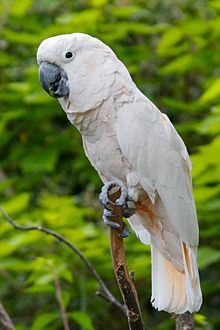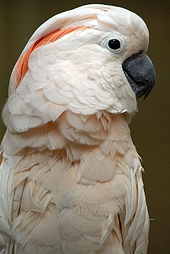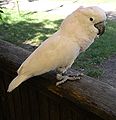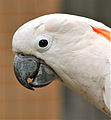- Salmon-crested Cockatoo
-
Salmon-crested Cockatoo 
At Cincinnati Zoo Conservation status Scientific classification Kingdom: Animalia Phylum: Chordata Class: Aves Order: Psittaciformes Family: Cacatuidae Subfamily: Cacatuinae Genus: Cacatua Subgenus: Cacatua Species: C. moluccensis Binomial name Cacatua moluccensis
(Gmelin, 1788)The Salmon-crested Cockatoo, Cacatua moluccensis also known as Moluccan Cockatoo or M2[citation needed] is a cockatoo endemic to south Moluccas in eastern Indonesia. At 50 cm, it is among the largest of the white cockatoos. The female is larger than the males on average. It has white-pink feathers with a definite peachy glow, a slight yellow on the underwing and underside of the tail feathers and a large retractable recumbent crest which it raises when threatened, revealing hitherto concealed bright red-orange plumes to frighten potential attackers (may also be raised in excitement, or other 'emotional' displays). Some describe the crest as "flamingo-colored." It also has one of the louder calls in the parrot world and in captivity is a capable mimic.
In the wild the Salmon-crested Cockatoo inhabits lowland forests below 1000 m. The diet consists mainly of seeds, nuts and fruit, as well as coconuts. There is additional evidence that they eat insects off the ground, and pet Moluccan cockatoos have tested positive for anemia if their diet does not include enough protein.
Contents
Status in the wild
The Salmon-crested Cockatoo is a vulnerable species, and has been listed on appendix I of CITES since 1989, which makes trade in wild-caught birds illegal. Trade in captive bred birds is legal only with appropriate CITES certification. Numbers have declined due to illegal trapping for the cage-bird trade and habitat loss. During the height of the trapping of this species over 6,000 birds were being removed from the wild per year. It has a stronghold in Manusela National Park on Seram, although even today some illegal trapping continues.
Aviculture
The Salmon-crested Cockatoo can no longer be imported into the United States because it is listed on the Wild Bird Conservation Act. However, they are being bred in captivity. They are popular for their beauty and trainability (which makes them popular in trained bird shows). The Salmon-crested Cockatoo is widely considered to be one of the most demanding parrots to keep as a pet due to their high intelligence, large size, potential noise level, and need to chew. Moluccan cockatoos require a very large and very sturdy cage or aviary. Salmon-crested Cockatoos are highly social and pets can be extremely cuddly, affectionate, and gentle birds. This can lead to problems if a young cockatoo is spoiled with a great deal of attention and cuddling when young and does not get the opportunity to learn to play with toys, forage, or otherwise entertain itself. Salmon-crested cockatoos require a great deal of attention and activity to remain healthy and well-adjusted. Attention and training from human caregivers is important in keeping them occupied, as are chewable toys and foraging toys that require them to work for their food. As with most large cockatoos, the Salmon-crested Cockatoo may develop health and behavioral problems such as feather-plucking and aggression if not provided with the appropriate environment, attention, and enrichment opportunities.
Gallery
References
- BirdLife International (2004). Cacatua moluccensis. 2006. IUCN Red List of Threatened Species. IUCN 2006. www.iucnredlist.org. Retrieved on 11 May 2006. Database entry includes justification for why this species is vulnerable
External links
- World Parrot Trust Parrot Encyclopedia - Species Profiles
- ARKive - images and movies of the Salmon-crested Cockatoo (Cacatua moluccensis)
- BirdLife Species Factsheet
- IUCN Red List
- Red Data Book
- Moluccan Cockatoo photo on Pc-Zoo
- Project Bird Watch & eco-tourism development in Indonesiion Islands
- 9 Steps To Avoid “Unwanted Cockatoo Syndrome”
Cockatoos (family: Cacatuidae) Appearance Small NymphicusBlack Calyptorhynchus
(subgenus)Zanda
(subgenus)ProboscigerPink or grey CallocephalonEolophusLophochroaWhite CacatuaCacatua
(subgenus)Yellow-crested Cockatoo (or Lesser Sulphur-crested Cockatoo) (supporting page: Citron-crested Cockatoo) • Sulphur-crested Cockatoo (supporting page: Eleonora Cockatoo) • Blue-eyed Cockatoo • White Cockatoo (or Umbrella Cockatoo) • Salmon-crested Cockatoo (or Moluccan Cockatoo)Licmetis
(subgenus)Long-billed Corella • Western Corella (supporting pages: Muir's Corella • Butler's Corella) • Little Corella • Tanimbar Corella (or Goffin's Cockatoo) • Solomons Cockatoo • Red-vented CockatooCategories:- IUCN Red List vulnerable species
- Cockatoos
- Birds kept as pets
- Birds of Indonesia
- Birds of Southeast Asia
- Cacatua
- Parrots
- Talking birds
- Animals described in 1788
Wikimedia Foundation. 2010.






